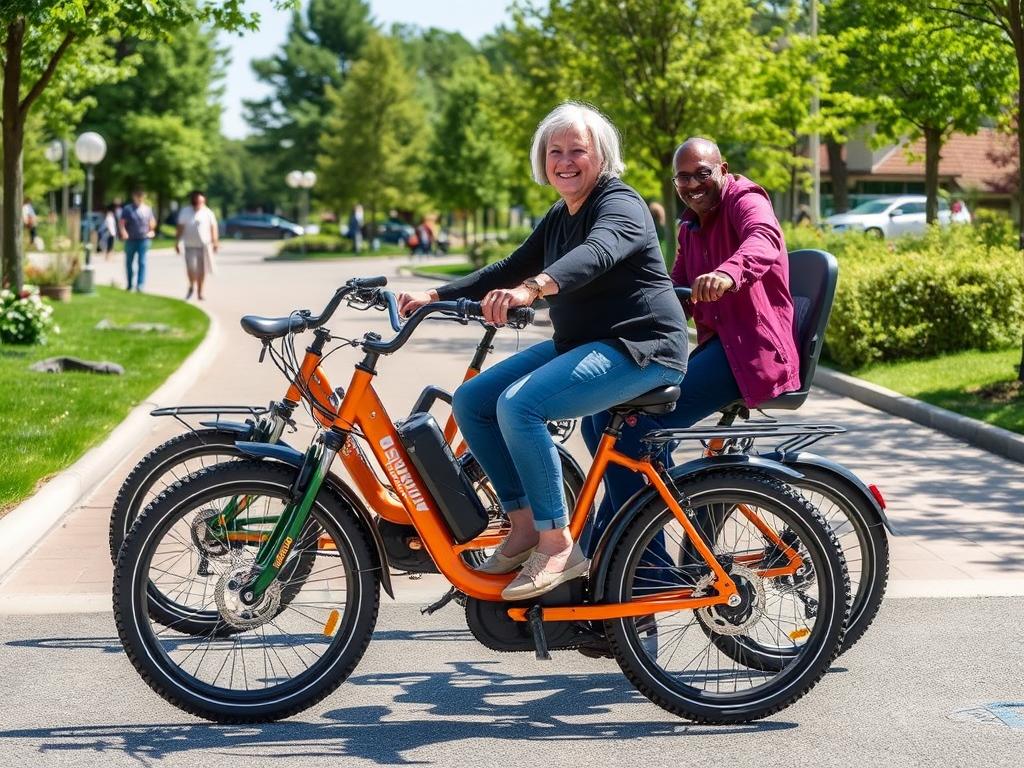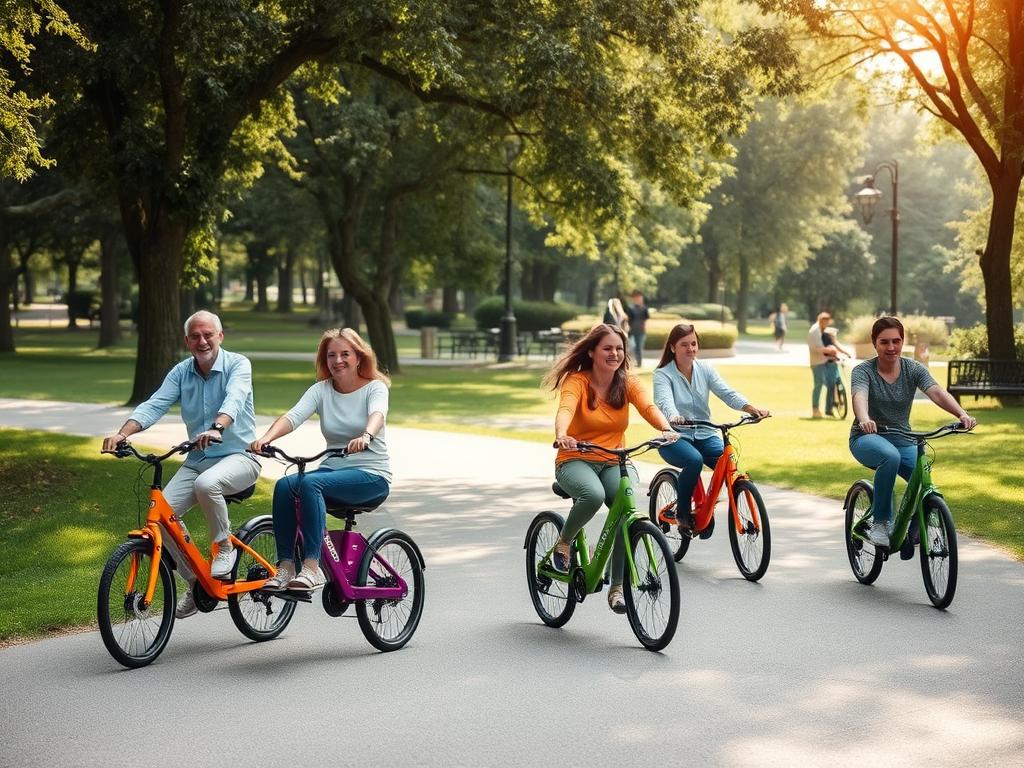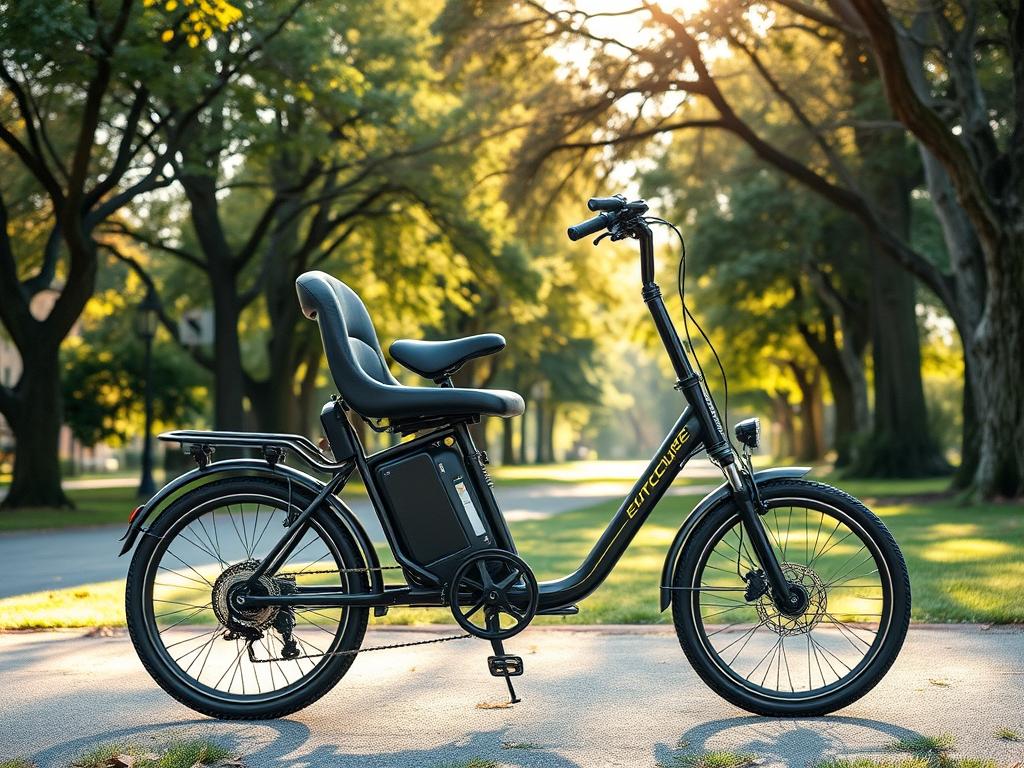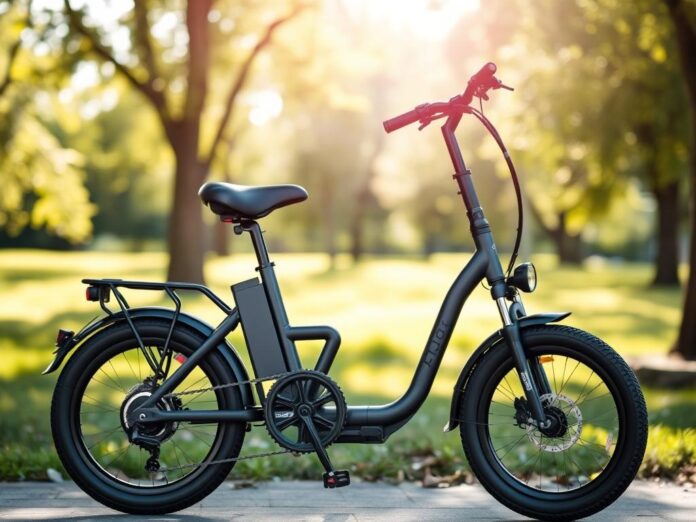Limited mobility electric bikes are changing the game for riders facing physical challenges. These power-assisted bicycles offer a new level of freedom and independence. Whether you’re recovering from an injury or dealing with age-related mobility issues, handicap-accessible e-bikes can help you stay active and engaged.
Recent studies show that cycling isn’t just for the young. About 40% of people aged 50 to 86 learned to ride as adults. Even more surprising, 10% first hopped on a bike after turning 50. This trend is particularly strong among those over 60, according to federal data.
Limited mobility electric bikes come in various designs to suit different needs. You’ll find upright tricycles for added stability, semi-recumbents for comfort, and even tandems for shared rides. Each type is crafted to ensure a safe, comfortable, and accessible riding experience for all ages and abilities.
For example, the E-Joe Anggun 3.0 Electric Senior Bike boasts an impressive 50-mile range between charges. The Pedego Boomerang Step-Thru features a frame just 9 inches high, making it easy to mount and dismount. Urban dwellers over 60 might appreciate the Rad Power Bikes Radcity Step-Thru 3, designed with city living in mind.
Key Takeaways
- Limited mobility e-bikes offer independence for riders with physical challenges
- E-bikes cater to various needs with different designs like tricycles and semi-recumbents
- Many adults learn to ride bikes later in life, with cycling popular among those over 60
- Step-through frames provide easier mounting and dismounting
- E-bikes can offer impressive ranges, with some models reaching 50 miles per charge
- Urban-specific models are available for city dwellers with limited mobility
What Are Electric Bikes for People with Limited Mobility?
Electric bikes for people with limited mobility are designed to help riders who face physical challenges. These disability-friendly electric cycles offer support and independence. They are perfect for seniors and those with mobility issues.
Definition and Key Characteristics
These e-bikes have electric motors, customizable attachments, and adaptive designs. They have lower step-through heights, wider seats, and better stability. Senior citizen e-bikes are made for comfort and ease of use.
How They Differ from Standard Electric Bikes
Mobility-focused electric bikes are different from standard e-bikes in several ways:
- They offer additional postural support
- They have specialized seating options
- They are easier to mount and dismount
- They have customizable controls for those with limited hand dexterity
Benefits of Electric Bikes for Accessibility
Electric bikes are great for assisted living transport. They provide:
- Increased independence
- Improved mobility
- Access to outdoor activities
- Low-impact exercise opportunities

Types of Mobility-Focused Electric Bikes
There are many types of electric bikes for different mobility needs:
| Type | Features | Best For |
|---|---|---|
| Upright Tricycles | Three wheels for stability | Balance issues |
| Semi-Recumbents | Reclined seating position | Back problems |
| Tandems | Two-person seating | Riders needing assistance |
| Handcycles | Hand-powered | Limited leg mobility |
With these options, there’s a suitable electric bike for almost every mobility need. This enhances the quality of life for many individuals.
Why Choose an Electric Bike for Limited Mobility?
Electric bikes are changing lives for people with limited mobility. They offer many benefits that can greatly improve life quality. Let’s see why e-bikes are a great choice for more independence and mobility.
Enhanced Independence and Freedom
E-bikes give a new sense of freedom to those with mobility issues. A study found that 75% of seniors with mobility problems felt lonely. E-bikes help riders go further and connect with their communities.
Reduced Physical Strain
E-bikes are great because they don’t strain the body as much. They’re perfect for seniors with chronic diseases, helping them stay active. The electric help makes it easy to ride up hills and long distances.
Improved Accessibility to Outdoor Activities
E-bikes make outdoor activities accessible for those with mobility issues. Models like the Happy Voyager and Happy Folding Pro are great for long trips or nature trails. This opens up new opportunities for mental health and socializing.

Versatility Across Different Terrains
E-bikes work well on many terrains, from city streets to rural paths. This is especially helpful for seniors in rural areas with limited transport options. It makes cycling easy and accessible everywhere.
| E-Bike Model | Motor Power | Battery Range | Special Features |
|---|---|---|---|
| Happy Folding Pro | 750W | Up to 45 miles | Folding design, compact and portable |
| Happy Voyager | 750W | Long-range | Step-thru frame, suitable for longer trips |
Choosing an e-bike can bring back independence, improve fitness, and let people enjoy the outdoors. These innovative solutions are changing lives, one ride at a time.
Features to Look for in an Electric Bike for Limited Mobility
When picking out an electric bike for limited mobility, look for features that boost comfort and safety. Let’s dive into the important elements to consider in disability-friendly electric cycles.
Step-Through Frame Designs
Step-through frames are key for easy mounting. The Pedego Boomerang Step-Thru has a 9-inch high frame. It’s perfect for those with mobility issues.
Stability Enhancements
Stability is crucial in electric bikes for people with disabilities. The SixThreeZero Electrified EvryJourney 250W Tricycle is a great example. It has three wheels, goes up to 15 mph, and lasts 50 miles on a charge.
Adjustable Seating and Handlebars
Customizable comfort is essential. Look for e-bikes with adjustable seats and handlebars. This ensures a perfect fit. The Lectric XP Step-Thru 3.0 EBike, with a 4.9/5 star rating from over 5,900 customers, offers this flexibility.
Safety Features for Limited Mobility
Safety is a must in handicap-accessible e-bikes. Look for strong braking systems and supportive seating. The Lectric XP Step-Thru 3.0 supports riders up to 330 pounds and cargo up to 150 pounds. It ensures stability and safety.
| E-Bike Model | Key Feature | Range | Max Speed |
|---|---|---|---|
| Lectric XP Step-Thru 3.0 | Foldable design | Up to 65 miles | Not specified |
| SixThreeZero EvryJourney 250W | Tricycle design | Up to 50 miles | 15 mph |
| Electric Volt Elegant Senior | Pedal-assist mode | 40 miles | 20 mph |
| E-Joe Anggun 3.0 | Senior-friendly | 50 miles | Not specified |
Best Electric Bikes for Limited Mobility in 2024
Power-assisted bicycles have changed the game for those with mobility issues. In 2024, there’s a wide range of options for seniors and those with limited mobility. Let’s look at the top picks for senior citizen e-bikes and riders with mobility challenges.
Electric Tricycles for Stability
Electric tricycles are known for their stability. The SixThreeZero Electrified EvryJourney 250W Tricycle is a standout. It has a low step-through frame and lots of space for cargo. It’s ideal for seniors who need balance and can carry a lot.

Folding Electric Bikes for Accessibility
Folding e-bikes are great for easy storage and transport. The Lectric XP Step-Thru 3.0 EBike is a favorite. It’s small but packs a punch with a 750W motor and up to 45 miles on one charge.
Lightweight Electric Bikes
For a lighter ride, check out the Specialized Turbo Como SL 5.0. It’s sleek and powerful but light. This makes it easy to handle, especially for those with less strength.
High-Performance Models for Varied Needs
The Rad Power Bikes Radcity Step-Thru 3 is great for city-dwelling seniors over 60. It’s practical for the city and has a step-through frame that’s just 9 inches high. This makes it easy to get on and off.
| Model | Best For | Key Feature |
|---|---|---|
| SixThreeZero EvryJourney | Stability | Low step-through frame |
| Lectric XP Step-Thru 3.0 | Portability | Foldable design |
| Specialized Turbo Como SL 5.0 | Lightweight Riding | Reduced weight |
| Rad Power Radcity Step-Thru 3 | Urban Use | 9-inch step-through height |
When picking power-assisted bicycles, think about what you need. These e-bikes for seniors have long battery life, adjustable parts, and can carry a lot. They meet different rider needs.
How to Choose the Right Electric Bike for Limited Mobility
Finding the perfect electric bike for limited mobility can change your life. With new inclusive cycling technologies, picking the right bike is key. Let’s look at how to make the best choice.
Assessing Individual Mobility Needs
First, think about what you need. Look at your physical limits and how you plan to use the bike. Are you looking for assisted living transport or just for fun? Your answers will help you choose.
Testing Comfort and Fit
Comfort is very important. Try out different bikes to find the perfect fit. Look for:
- Low step-through frames
- Adjustable seats and handlebars
- Easy-to-use controls
The Pedego Boomerang Step-Thru is great because it’s only 9 inches high, making it easy to get on.
Budget Considerations and Financing Options
E-bikes come in different prices. Set a budget that includes the bike, extras, and upkeep. Many places offer financing to help with costs.
Understanding Warranty and After-Sales Support
A good warranty can save you money and stress. Check the length of the warranty and what it covers. Also, make sure there’s reliable support after you buy.
| Feature | Importance | Example |
|---|---|---|
| Step-through frame | High | Pedego Boomerang (9″ height) |
| Battery range | Medium | E-Joe Anggun 3.0 (50 miles) |
| Motor power | High | Happy Folding Pro (750W) |
| Urban suitability | Varies | Rad Power Bikes Radcity Step-Thru 3 |
Choosing the right e-bike can greatly improve your life. Take your time, do your homework, and pick a bike that fits your needs perfectly.
Maintenance and Care for Electric Bikes for Limited Mobility
Keeping your power-assisted bicycle in good shape is key to its long life and performance. This section will give you important maintenance tips for your electric bike.
Battery Care and Charging Best Practices
Keep your e-bike’s battery charged between 20% and 80%. Stay away from very hot or cold temperatures. Charge it after each ride. Most e-bikes have lithium-ion batteries, giving you 20 to 100 miles per charge.
Routine Inspections for Safety
Always check your brakes before you start riding. Listen for any odd sounds when you press them. Make sure tire pressure is above 50-55 PSI, aiming for 60 PSI if you’re over 200lbs. Also, check the chain or belt drive system often for wear.
Cleaning and Lubrication Tips
Use bike-specific, biodegradable cleaners for your e-bike. Don’t use high-pressure water on electrical parts. Lubricate the chain to save energy, but clean off any extra oil. Belt drive systems don’t need oil but should be checked for damage.
Seasonal Storage and Usage Tips
Store your e-bike in a dry spot, away from extreme temperatures. Keep the battery charged while it’s stored. For winter, use wider tires for better grip.
| Maintenance Task | Frequency | Importance |
|---|---|---|
| Battery Charging | After each ride | High |
| Brake Check | Before each ride | Critical |
| Tire Pressure Check | Weekly | High |
| Chain Lubrication | Monthly | Medium |
| Full Cleaning | Quarterly | Medium |
Benefits of Electric Bikes for Rehabilitation and Therapy
Electric bikes are changing the game in rehabilitation. They offer many benefits for those recovering from injuries or managing chronic conditions. E-bikes provide a low-impact way to exercise, tailored to each person’s needs.
Low-Impact Exercise Options
E-bikes are a gentle way to exercise without straining joints or muscles. The assistive pedaling lets riders control their effort. This makes them perfect for those recovering or dealing with arthritis. It’s a low-impact exercise that helps rebuild strength and improve mobility slowly.
Boosting Mental Health Through Mobility
Getting back on your feet can greatly improve mental health. E-bikes give riders a sense of independence and freedom. This can lift their mood and reduce stress.
Being able to explore outdoors and enjoy fresh air also boosts mental health during recovery.
Encouraging Social Interactions
E-bikes help people stay connected with friends and family while recovering. They allow for group rides or outdoor activities. This fosters social interactions that are key for emotional well-being.
Progress Tracking and Fitness Features
Many e-bikes have features to track progress. They monitor distance, speed, and heart rate. This data is useful for riders and healthcare providers to see improvements in strength and mobility.
Using e-bikes in rehabilitation programs can lead to faster recovery. They are a versatile and effective tool for therapy and rehabilitation. Whether it’s recovering from a broken leg or managing a chronic condition, electric bikes are a valuable asset.
Safety Considerations for People with Limited Mobility
When riding handicap-accessible e-bikes, safety is key. People with limited mobility must take extra steps for a safe and fun ride on disability-friendly electric cycles.
Importance of Safety Gear
Wearing the right safety gear is a must. A helmet made for e-bikes is the first thing to get. Also, wear reflective clothes and lights to be seen better when it’s dark.
Easy-to-Use Controls and Navigation Systems
Disability-friendly electric cycles have controls that are easy to use. They have big buttons, clear screens, and voice guides. These help riders feel sure about using their bikes.
Choosing Safe Routes
Choosing the right path is important for safety. Pick bike lanes, quiet streets, or trails. Stay away from busy areas and tough terrains that could be risky.
Emergency Features and Backup Options
Many handicap-accessible e-bikes have safety features built in. They have GPS, emergency call buttons, and extra batteries. These features give riders peace of mind while they ride.
| Safety Feature | Benefit |
|---|---|
| GPS Tracking | Allows location monitoring |
| Emergency Call Button | Quick access to help |
| Backup Battery | Extends ride range |
| Adjustable Speed Limits | Customizable control |
By focusing on these safety points, riders with limited mobility can enjoy e-bikes safely. This way, they can have a great time without worrying about risks.
Legal and Accessibility Regulations for Electric Bikes
Electric bikes for those with limited mobility are becoming more popular. The eBike market grew by over 23% in 2020. This growth has led to new rules in the United States, affecting riders and transport options in assisted living.
ADA Compliance for Electric Bikes
Electric bikes for limited mobility must follow ADA standards. These rules make sure e-bikes are safe and accessible for people with different mobility needs. Manufacturers are making models that meet ADA guidelines, making them good for use in assisted living and public areas.
Legal Speed and Power Limits
Forty-eight states have laws about e-bikes, with 39 using a three-tiered system. This system limits speeds to 20-28 mph, based on the class. Also, 25 states and Washington D.C. require helmets for e-bike riders and passengers, while 25 states don’t.
Licensing and Registration Requirements
Licensing rules for e-bikes vary a lot. Seven states, like Alabama and Alaska, require a license to ride an e-bike. But most states don’t need registration for limited mobility electric bikes. Always check local rules before riding, as they can affect where and how you use your e-bike for transport.
Accessible Paths and Trails
Many places are making paths and trails for electric bikes and other mobility devices. This includes bike lanes and trails for everyone. Remember, e-bikes need lights and reflectors as state laws require. Some places, like college campuses, have rules for parking and charging e-bikes and personal mobility devices, ensuring safety and access for all.






